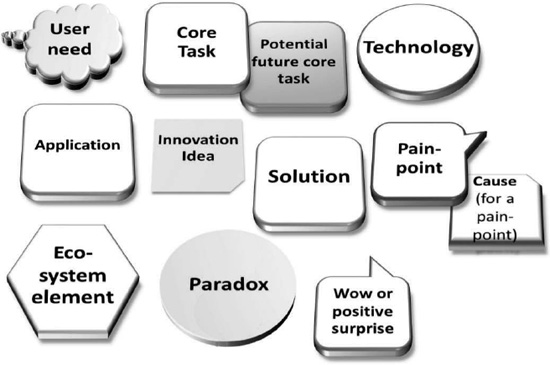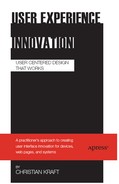Overview of Methods and Chapters
This book contains two short introductory chapters followed by 17 chapters giving tangible methods for user experience innovation. Following is a quick summary of the content:
- Chapter 1: User Experience and Why It Matters: Introduces you to what user experience is, including some basic terms related to user experience.
- Chapter 2: Innovating in User Experience: When is a user experience innovation a success? How did Apple manage to change the rules of the smart phone industry with a single product? What is important for your company or product to become successful? These and other questions are answered in this chapter.
- Chapter 3: Identifying Target Users: Discusses identifying and defining who you are targeting, which is absolutely key for creating successful user experience innovation. This chapter will give you some methods on how to identify your target users.
- Chapter 4: Identifying User Needs: Gives guidance on how to find the user needs of your target users. User needs are the basis of all user experience innovation.
- Chapter 5: Identifying Core Tasks: Provides methods for identifying current and future core tasks for your product. Core tasks can be used directly or indirectly for user experience innovation.
- Chapter 6: Innovating Around Core Tasks: Describes how to come up with user experience innovations directly based on the core tasks that users perform using your product.
- Chapter 7: Innovating for New Technologies: Describes a tangible method for creating user experience innovation around technologies by examining basic user needs.
- Chapter 8: Innovating for Applications: Describes methods to create user experience innovation by focusing on how applications can be linked together seamlessly.
- Chapter 9: Relieving the Pain: Shows how you can identify pain points in the user experience of your existing product(s). I will also describe how removing pain points from your user experience can improve your overall user experience radically. Finally, you will realize how you can use your pain points to create successful user experience innovations.
- Chapter 10: Innovating Around First Impressions: Suggests methods to improve and innovate around the first impressions of your webpage, device, or system. The first impression is essential for your product and how it is received and perceived in the market.
- Chapter 11: Creating Positive Surprises: The Wow Factor: Covers the importance of creating a wow factor for your product. Creating small—or big—positive surprises can change your product from a mediocre product to a winning product. Positive surprises and wow are key factors in successful user experience innovation.
- Chapter 12: Innovating Around an Ecosystem: Helps you think beyond your product to the wider experience in which the product is used. User experience innovation is not only about improving the core of your product, but also very much about innovating for the entire ecosystem of your product.
- Chapter 13: Innovating with Lead Users: Why bother creating innovation inside the company if you can have lead users help you in the innovative process? This chapter describes tangible methods for this.
- Chapter 14: Copying with Pride: Talks about copying and building upon the innovations of others. Most successful innovations in the world were not new when they were launched, but rather became successful because an innovating company came up with just the right implementation, or because the company applied an existing innovation to a new type of product or platform. This chapter will describe how you can copy with pride—but at the same time making sure to do it right.
- Chapter 15: Innovating Around Paradoxes: Teaches how to resolve and benefit from conflicting needs. Paradoxes include conflicting user needs and conflicting needs from your shareholders and your management. In resolving paradoxes, you will find great opportunity to create successful products.
- Chapter 16: Innovating Around Context Awareness: Suggests tangible methods to innovate around situational awareness in your products. Context awareness is the ability for your product to know the situation that your user is in, where the user is, and what he or she may want to do. Context awareness can be a goldmine of potential successful innovation.
- Chapter 17: Innovating Around New Products and Users: Walks you through using all previously described methods to create a superb user experience for a product with a new target user group, or for a completely new product.
- Chapter 18: Prototyping and Verifying Solutions: Goes through tangible and simple methods to create prototypes and verify solutions with target users. Your user experience innovation ideas need to be verified with your target users, ideally at every step of your iterative innovation process. For any verification you will need one or more prototypes of some sort.
- Chapter 19: Meeting Organizational Challenges: Describes approaches to use in challenging attitudes and old ways of thinking that get in the way of bringing successful user experience design to an organization or product. User experience innovations and ideas will never be heard in a majority of organizations and companies. This is very sad, not only for you as a user experience person, but also for your company. Tomorrow’s battleground for most consumer products will be on the user experience front, and if your company does not catch up, then the reality of losing market share and profits will be inevitable. This chapter can help you sell the need for good user experience design to management and colleagues.
- Conclusion: Provides a short wrap-up to the book.
Figure I shows the methods described in this book in conjunction with inputs such as user needs and technology choices. Looking at the figure you can begin to get a feel for how you can start thinking of user experience fro the standpoint of user needs and use the methods in this book to work through to successful product solutions.

Figure 1. Overview of the methods for successful user experience innovation described in this book
You will realize that several of the methods I describe in the following chapters are pretty obvious and straightforward. That is OK. Making these straightforward is the entire goal of the book. Demystifying user experience innovation and making it applicable to any company, organization, or person is precisely my purpose.
I am not claiming that the methods in this book are the only right ways to create true user experience innovations. But I am claiming that they have worked for me. I have personally used all the described methods, and very often with success. The methods have led me to success when it comes to creating user experience innovations that consumers love, and that are profitable and patentable.
